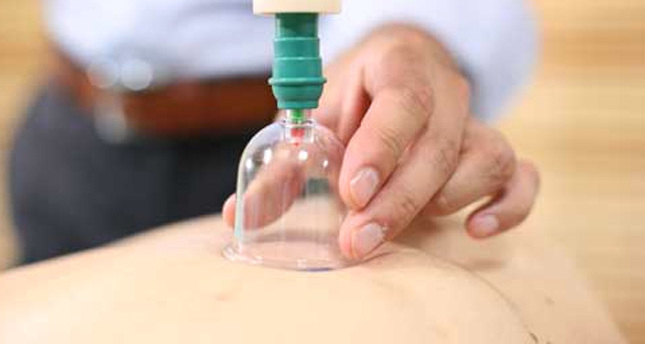An ancient treatment from the pages of the Ebers Papyrus

Many people suffer from various ailments such as severe headache or backache that prevents them from working efficiently throughout the day. Thankfully, there is a quick and painless age-old remedy called ‘hacamat’, cupping, that requires no bed rest
Hacamat is a general treatment used in preventive medicine and to treat diseases. The word "hacamat" originally comes from the Arabic word "hacm," which means to absorb – in other words, blood letting. A person who practices this profession is called a "haccâm," and the equipment used during the treatment is called "mihcem." Many people know that hacamat is one of the Sunnah (practices) of the Prophet Muhammed, and apart from being the treatment of a specific disease, hacamat is a method used to withdraw blood from a patient to cure or prevent illness and disease. The blood that is withdrawn from the body is not arterial blood, but dark, coagulated blood from under the skin. Another important component of hacamat is that the end of spring or at the beginning of June is the preferred time to carry out the procedure, as blood circulation improves more properly in the warm weather.There are two methods used to perform this ancient treatment. One is traditional cupping applied using heated cups, which are fixed reversely onto the body of the patient, in order to gather blood at the targeted area. In this case, the cups are hot and have a stimulating effect. This is generally called "kuru hacamat" (dry hacamat). But if the purpose is bloodletting, the surface of the skin is scratched with the help of a "bistoury," and wide mouthed glass jar is fixed to the body in order to let the blood flow into the jar. This method is called "kanlı hacamat" (blood hacamat), which is generally preferred by patients. This blood is not withdrawn from the veins, but from the skin. As soon as the dark and coagulated blood flows out, this technique is said to promote blood circulation, remove stasis and alleviate swelling and pain. This method may be applied to various regions of the body, but places near the diseased organs are preferably targeted.History of hacamatThere is no exact information concerning when and where Hacamat began, but rumors tell us it was a technique used in ancient civilizations in Mesopotamia, Egypt and Asia. Hacamat uses the same methods of cupping therapy that the ancient Chinese used in their form of alternative medicine. This treatment used to be applied using animal horns. The person performing the hacamat would use the horns as a vacuum by deflating the air inside the horns. Besides animal horns, bamboo and ceramic and glass cups have also been used. Hacamat was used systematically in ancient Mesopotamia in order to purify the body, and there are some documents still in existence that depict medicinal bloodletting. It is also possible to find evidence in the Ebers Papyrus, an Egyptian compilation of medical texts dating to around 1550 B.C., one of the oldest known medical works. Hippocrates, the father of medicine, and Galen, the greatest physician of Ancient Greek medicine, mentioned hacamat in their teachings. Hacamat is a 2,500-year-old practice in traditional Mongolian medicine as well.Since the greatest physicians such as Hippocrates and Galen regarded this method as a safe treatment option, Islamic physicians and scholars of ancient civilization accepted this theory as well.Hacamat treatment pointsIt is crucial to know about hacamat's treatment points because hacamat is only applied to certain places on the body: the head, back, upper and lower limbs and legs. It is said that the front part of the body has limited treatment points, whereas the most beneficial parts are on the back of the ears and head, center of the head, and upper back between the shoulders. Aside from these points, hacamat is also applied to various other parts of the body as well.What is a patient supposed to do before hacamat?It is suggested that the patients eat nothing before hacamat is carried out, as well as to avoid sexual intercourse either the day before or the day after. It is also not advisable to drink too much water or eat animal-derived food for 48 hours. Additionally, avoid eating salty, spicy and sour foods.Is it painful?So far, studies demonstrate that there are no adverse effects of hacamat, as it is a natural therapy. It is also crucial to use clean, hygienic equipment. If clean and sterilized instruments are used, patients will get positive results within the same day without pain or scarring. As it has been known as the quickest treatment method for many centuries, hacamat is commonly practiced in Asia, Africa and Far Eastern countries. In Europe, it has become an alternative treatment in recent years.The following are some of the diseases and ailments that hacamat may treat:Chronic coughs and lung diseases, hypertension (high blood pressure), stomach problems and ulcers, renal (kidney) disease, irritable bowel syndrome, depression, withdrawal, insomnia (inability to sleep), psychological conditions and nervousness, excessive sleep, neck and shoulder pain, back pain, rheumatoid arthritis and severe headaches (migraine). An American professor claimed that hacamat may treat 90 percent of diseases, and research conducted in Europe, Asia and other various places in the world support this claim. Hacamat is one of the most demanded traditional treatment methods, and it must be emphasized that it is crucial that authorized experts must apply this method in order to prevent adverse outcomes
Last Update: December 31, 2014 02:21
